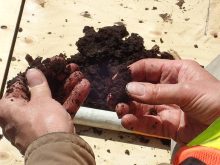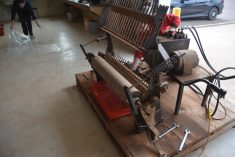Potato growers who use foliar phosphorus acid to lower the risk of storage loss might not need to be so picky when it comes to application, according to recent research.
Until now, the need to avoid phototoxicity during application has been emphasized. Producers were advised to apply early in the morning or risk chemical burn on potato leaves.
However, Manitoba-based trials indicate time of day might be an overgeneralization, and that phototoxicity, when it does occur, is likely not causing enough damage to affect yield.
Read Also

Still hard to predict precise fertilizer payback
Despite decades of advances, international research finds no clear answer for where and when adding nutrient will fail to boost growth.
“It’s really easy for growers to see speckling, very minor amounts of damage, and that speckling is extremely undesirable from a viewing standpoint, but most likely not agronomically significant,” said Zachary Frederick, applied potato research agronomist with the Canada-Manitoba Crop Diversification Centre (CMCDC) near Carberry.
“As far as growers trying to control that speckling, we suspect that it’s more of an environmental than a dose response.”
Why it matters: Phosphorus acid has been used to prevent potatoes from rotting in storage, which has been a serious challenge for Manitoba growers in the recent past.
Phototoxicity is one of many topics being tackled in the potato plots at CMCDC. Frederick’s trial, which took place last year, tested different concentrations of phosphorus acid applied in the morning and in the heat of the day.
All plots received 10 litres of product throughout the season in different rates. Alongside an untouched control, plots received either four treatments of 2.5 litres per acre, three treatments of 3.3 litres per acre, a ramp up (with the first two treatments at two litres, increasing to three for the final two passes), or a double-rate burn-off of four treatments of five litres per acre.
Outside the latter group, some plots did see leaf speckling, Frederick said, but damage seemed less correlated to rate or time of day and more to the day’s UV index and, perhaps, canopy humidity.
Last year the centre experienced very smoky days during some applications. Those plots saw no phototoxicity damage, regardless of time of day the product was applied.
Vikram Bisht, a Manitoba Agriculture industry development specialist focused on horticulture, has seen similar results. His trials did not show a yield hit from phototoxicity, even in plots purposefully designed to ignore common phosphorus acid usage.

Bisht used anywhere from five litres to 14 litres per acre, compared to the maximum recommended rate of eight. All treatments were applied between 11 a.m. and 3 p.m., well outside the normal window.
“Even though I had used very high rates for many applications, I did not see any impact to yields,” he said. “My crop was good.
“So, yeah, there is a possibility of some phototoxicity on the leaves, which in some cases, it doesn’t look like a healthy crop, but it’s a small necrosis on the leaves…it does not affect the yields.”
In his opinion, wind shear in Manitoba is a much bigger threat to foliage than phototoxicity.
However, badly burned leaves can be more brittle and vulnerable to wind damage.
Wasted potential?
Bisht argued that the product has more potential than the seed potato industry is using it for now.
While seed growers in Manitoba have been reluctant to use phosphorus acid, due to claims that the product slows germination and limits yield, Bisht says he used it during his years managing a U.S. seed potato farm in Maine.
“We used it on the crop coming in and we did not see any phytotoxicity because of that in the seed crop,” he said. “I hope some more people get involved and use it on a seed crop also.”
Bisht added that farms producing their own seed might use the product, but commercial seed potatoes treated with phosphorus acid may be a turnoff for buyers.
The topic might be even more relevant, given the curve-balls Mother Nature has thrown the potato harvest. Potatoes went into storage in good condition last year — a silver lining from the 2021 drought — but both 2019 and 2020 brought significant harvest challenges, leading to storage woes later in winter.
Dan Sawatzky, manager of the Keystone Potato Producers Association, said some seed potato producers are reluctant to use phosphorus acid.
“I think some seed producers would like to use (it). They see some benefit in storability and those sorts of things, but at one point, there had been some research done earlier that pointed to caution…
“Until we’ve been able to prove otherwise, I think people continue to be cautious.”
Studies like Bisht’s and those at the CMCDC play into that conversation, he added.
Sawatzky urged all producers to note proper label rates for the product. Some growers shy away from the full rate for fear of phototoxicity.
Foliar application is the most popular method of application now. In the past the product was commonly applied directly to tubers before storage, said Sawatzky.
That method had coverage issues, and the need to set up and take down equipment during harvest was another deterrent.
Regardless, Sawatzky said some farms have switched back to pre-storage application.
















